SIDAC
SIDAC is a silicon (SI) diode (D), indicated for applications in circuits of alternating current (AC). This is precisely what the acronym for Silicon Diode for Alternating Current indicates.
This device has a trigger characteristic similar to that of the Diacs, but with the ability to operate at much higher voltages and currents.
In Figure 1, we have the characteristic curve of this component.
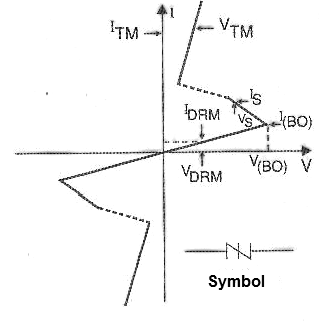
The SIDAC is a bilateral component, as we can see from the curves, which precisely makes it suitable for AC applications.
When the voltage between the SIDAC terminals is below a certain value V (BO), it is blocked. If the voltage exceeds this value, the device conducts and the voltage between its terminals falls to the direct conduction value V (TM) from the order of 1.1 V.
The current it can conduct in this state can reach 10 A for short pulses (10 us, 1 kHz repetition frequency).
Once triggered, the device remains in this condition until the maintenance conditions are exceeded, i.e., the current falls below a certain value or the applied voltage also falls beyond a certain value.
For typical SIDACs, such as those manufactured by ON or NTE, the burst voltages can range from 45 to 250 V with currents effective in the range of 1 to 10 A.
Because they can conduct intense currents in the trip, they are ideal devices for the control of small-sensitivity thyristors (TRIACs and SCRs) in power circuits. Among the most important applications indicated for the SIDACs we can mention:
Surge Protectors
Xenon Flashers
Relaxation Oscillators
Sodium vapor lamp starters
Ignition of systems using natural gas or oil
High Voltage Power Supplies
In Figure 2, we have information about a typical SIDAC from its datasheet.
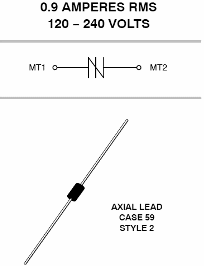
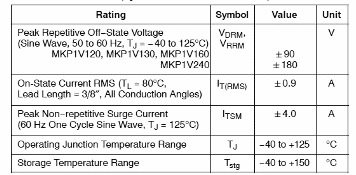
Note that unlike the other trigger devices we have studied, the SIDAC can handle relatively intense currents.
Here are some examples of practice.
A ON Semiconductor in an application note (AND8015 / D) presents an interesting practical application for your SIDAC MKP1V120RL.
As shown in Figure 3, this component can be used to extend the life of common incandescent bulbs.
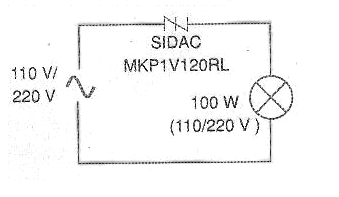
Although ordinary incandescent bulbs are no longer used in domestic lighting, there is still equipment of various types, such as small greenhouses, incubators, infrared sources and dryers that use this type of device.
An important case that is considered when using this circuit is that in places of difficult access, mainly external facilities, the cost and work of replacing the lamp in case of burning are significant, taking into account the extension of its life useful.
The device is connected in series with the lamp and its purpose is to reduce the RMS voltage applied to the filament and thus increase lamp durability.
It should also be considered that a reduced RMS voltage applied to the lamp reduces the power consumption.
It is claimed that the lamp life can be increased by 1.5 to 5 times, depending on the type and power. In this application, since the SICAD switches only with certain tension, part of the half-cycle applied to the lamp is cut as shown in Figure 4.
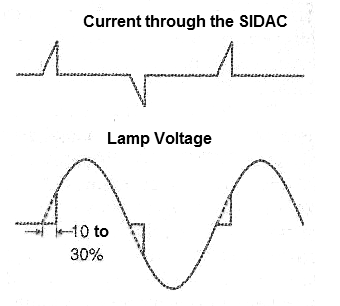
This cut, unlike what would occur with a resistive reducer, does not consume energy.
The conduction angle, using a SIDAC for 120 V can be between 110 and 130 degrees corresponding to power reductions of 10 to 30%.
EMI
It should be noted that the fast switching of a SIDAC causes this device to generate electromagnetic interference.
In the practical case of a circuit, like the one we have shown, this interference will appear mainly on AM radios which are connected close to the lamp.
A filter for noise reduction is shown in Figure 5.

It will be important that the resonance frequency of the circuit is above the audible limit so that it does not generate audible noises when in operation.
When choosing a SIDAC for a particular lamp, consider the peak current which occurs when it is turned on and the filament is cold (with less resistance).
Other Circuits
In Figure 6, we have a circuit of a Neon Flasher using a SIDAC by Teccor.
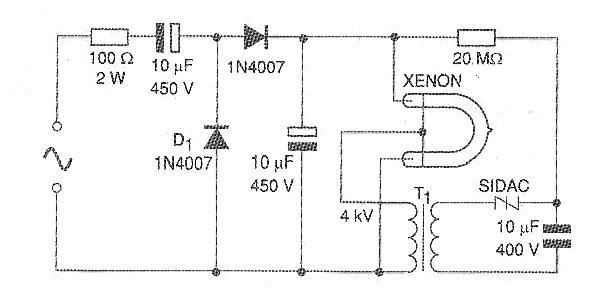
This company manufactures SIDACs from 79 to 330 V for applications like this.
This circuit is nothing more than a relaxation oscillator where the frequency depends on the capacitor load resistor next to the SICAD.
The 20 M resistor (22 M standardized) may have its value changed depending on the application.
The transformer used is a 4 kV pulse type for triggering common xenon lamps.
In Figure 7, we have a gas ignition circuit of the type found in common gas stoves, generating high voltage, also from a relaxation oscillator with a SIDAC.
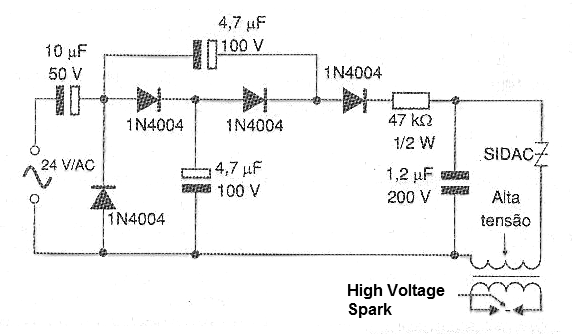
In Figure 8, we have the typical relaxation oscillator circuit with SIDAC with the formulas which allow us to calculate the values ??of its components.
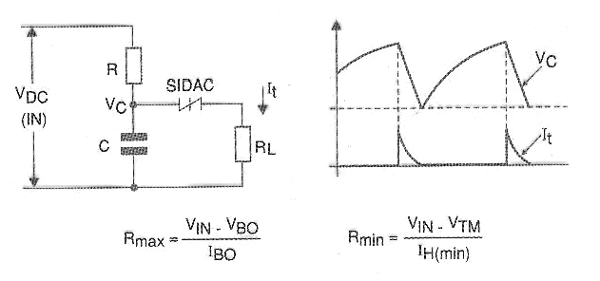
Note that the maximum and minimum values of R are critical depending primarily on the input voltage and the SIDAC triggering and maintenance voltages, in addition to the currents involved.
Also note that the waveform of this circuit is sawtooth, but with an exponential rise in voltage, given by the charge of capacitor C.
LASCR
LASCR or Light Activated SCRs are silicon controlled diodes, i.e., SCRs which can be triggered by light.
Its working principle is simple: all semiconductor junctions are sensitive to light, which can release load carriers and thereby increase the conduction of the devices.
Common SCRs are not affected by light because they are enclosed in opaque wrappings.
However, in the case of LASCRs, the enclosures are provided with a window which allows the incidence of light at the junctions, or are made in transparent plastic wrappers such as photodiodes and phototransistors.
As a result, the light causes an increase in the triggering current until the moment of switching. In Figure 9, we have the symbol used to represent this component.
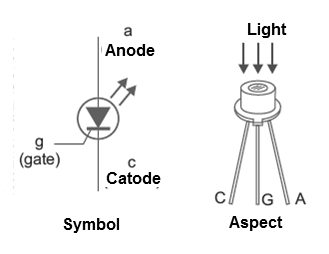
Currently, these devices are not widely used, with alternatives to light-emitting projects, which are not common.
An application for these devices is in the solid state relays already integrated with a transmitter.



